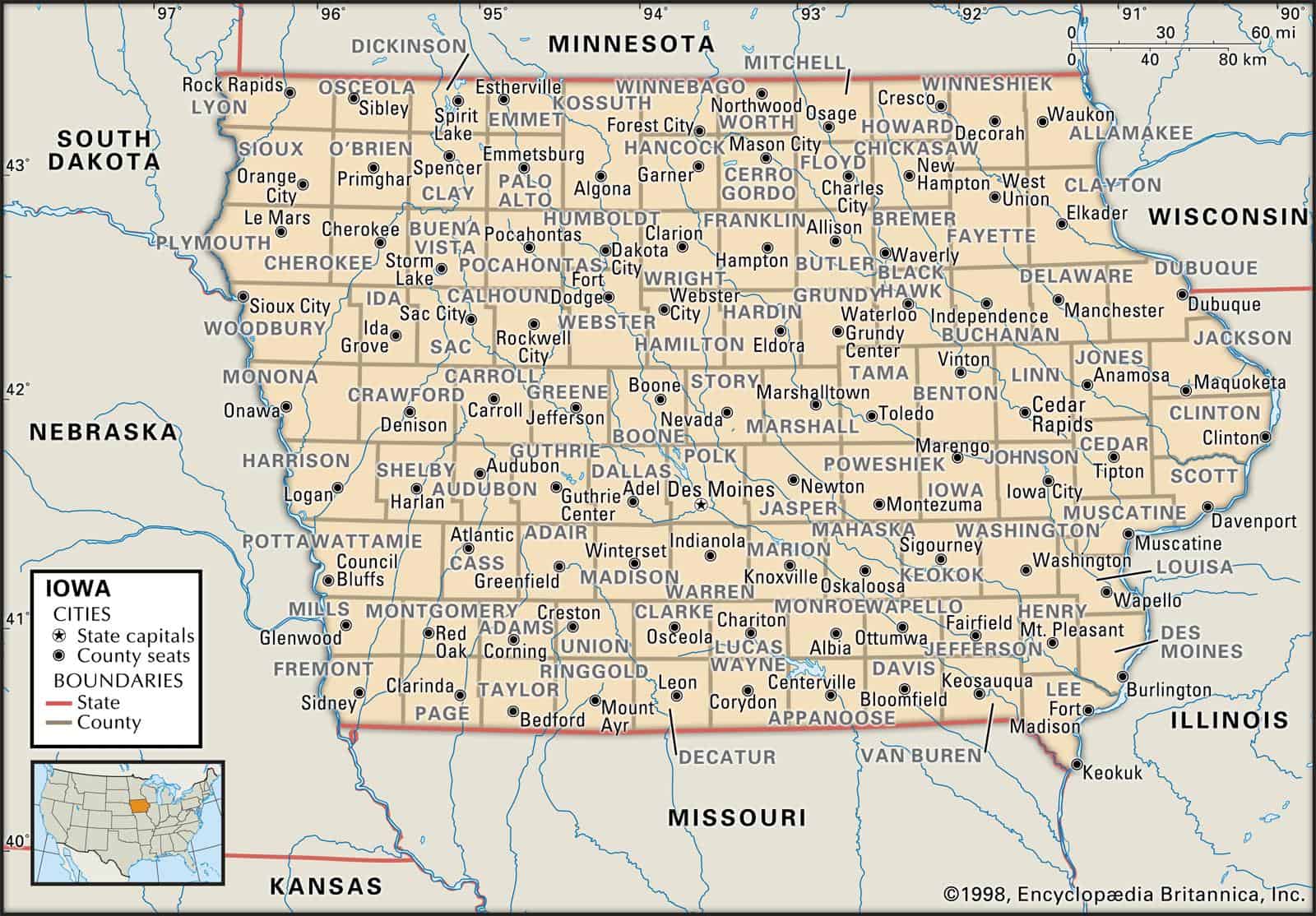
Maps of Iowa are an important element of ancestors and family history research, notably in the case that you live far from where your ancestor was living.
Due to the fact that Iowa’s political boundaries have often changed over the years, historic maps are essential in helping you uncover the exact location of your ancestor’s home, what land they owned, just who their neighbors were, and much more besides.
Maps of Iowa are an excellent tool for getting started with your own research because they provide useful information and facts instantly and present them in a clear and easily understandable format.
Iowa’s 10 largest cities are Des Moines, Cedar Rapids, Davenport, Sioux City, Waterloo, Iowa City, Council Bluffs, Ames, Dubuque, and West Des Moines.
Learn more historical facts about Iowa counties here.
Interactive Map of Iowa County Formation History
AniMap Plus 3.0, with the permission of the Goldbug Company.
List of Every Iowa County
Adair County
Adair County was established in 1851 and has a population of around 7,000. Its county seat is Greenfield, and the county is named after John Adair, the eighth governor of Kentucky.
Adams County
Established in 1851, Adams County has a population of around 3,600. Its county seat is Corning, and the county is named after John Quincy Adams, the sixth president of the United States.
Allamakee County
Allamakee County was established in 1847 and has a population of around 13,000. Its county seat is Waukon, and the county’s name comes from the Meskwaki word “alamikkie,” which means “the land of those who stayed behind.”
Appanoose County
Established in 1843, Appanoose County has a population of around 12,000. Its county seat is Centerville, and the county’s name comes from the Meskwaki word “upenoosaa,” which means “tall prairie grass.”
Audubon County
Audubon County was established in 1851 and has a population of around 5,700. Its county seat is Audubon, and the county is named after John James Audubon, the famous ornithologist and painter.
Benton County
Established in 1837, Benton County has a population of around 26,000. Its county seat is Vinton, and the county is named after Thomas Hart Benton, a Missouri senator who was a champion of western expansion.
Black Hawk County
Black Hawk County was established in 1843 and has a population of around 130,000. Its county seat is Waterloo, and the county is named after the famous Sauk leader Black Hawk.
Boone County
Established in 1846, Boone County has a population of around 26,000. Its county seat is Boone, and the county is named after the famous frontiersman Daniel Boone.
Bremer County
Bremer County was established in 1851 and has a population of around 24,000. Its county seat is Waverly, and the county is named after Fredrika Bremer, a Swedish author and feminist.
Buchanan County
Established in 1837, Buchanan County has a population of around 21,000. Its county seat is Independence, and the county is named after James Buchanan, the fifteenth president of the United States.
Buena Vista County
Buena Vista County was established in 1851 and has a population of around 20,000. Its county seat is Storm Lake, and the county’s name means “good view” in Spanish.
Butler County
Established in 1851, Butler County has a population of around 14,000. Its county seat is Allison, and the county is named after William Butler, a Kentucky congressman and officer in the Mexican-American War.
Calhoun County
Calhoun County was established in 1851 and has a population of around 9,000. Its county seat is Rockwell City, and the county is named after John C. Calhoun, a South Carolina senator and vice president.
Carroll County
Established in 1851, Carroll County has a population of around 20,000. Its county seat is Carroll, and the county is named after Charles Carroll, a signer of the Declaration of Independence.
Cass County
Cass County was established in 1851 and has a population of around 13,000. Its county seat is Atlantic, and the county is named after Lewis Cass, a Michigan senator and secretary of state.
Cedar County
Established in 1837, Cedar County has a population of around 18,000. Its county seat is Tipton, and the county is named after the Cedar River.
Cerro Gordo County
Cerro Gordo County was established in 1851 and has a population of around 43,000. Its county seat is Mason City, and the county’s name means “fat hill” in Spanish.
Cherokee County
Established in 1851, Cherokee County has a population of around 11,000. Its county seat is Cherokee, and the county is named after the Cherokee Nation.
Chickasaw County
Chickasaw County was established in 1851 and has a population of around 11,000. Its county seat is New Hampton, and the county is named after the Chickasaw Nation.
Clarke County
Established in 1846, Clarke County has a population of around 9,000. Its county seat is Osceola, and the county is named after James Clarke, the third governor of Iowa.
Clay County
Clay County was established in 1851 and has a population of around 16,000. Its county seat is Spencer, and the county is named after Henry Clay, a prominent American statesman.
Clayton County
Established in 1837, Clayton County has a population of around 17,000. Its county seat is Elkader, and the county is named after John M. Clayton, a Delaware senator and secretary of state.
Clinton County
Clinton County was established in 1837 and has a population of around 46,000. Its county seat is Clinton, and the county is named after DeWitt Clinton, the sixth governor of New York.
Crawford County
Established in 1851, Crawford County has a population of around 16,000. Its county seat is Denison, and the county is named after William H. Crawford, a Georgia senator and secretary of the treasury.
Dallas County
Dallas County was established in 1846 and has a population of around 96,000. Its county seat is Adel, and the county is named after George M. Dallas, the eleventh vice president of the United States.
Davis County
Established in 1843, Davis County has a population of around 9,000. Its county seat is Bloomfield, and the county is named after Garrett Davis, a Kentucky senator.
Decatur County
Decatur County was established in 1846 and has a population of around 8,000. Its county seat is Leon, and the county is named after Stephen Decatur, a U.S. naval officer.
Delaware County
Established in 1837, Delaware County has a population of around 18,000. Its county seat is Manchester, and the county is named after the Delaware River.
Des Moines County
Des Moines County was established in 1834 and has a population of around 39,000. Its county seat is Burlington, and the county is named after the Des Moines River.
Dickinson County
Established in 1851, Dickinson County has a population of around 18,000. Its county seat is Spirit Lake, and the county is named after Daniel S. Dickinson, a New York senator.
Dubuque County
Dubuque County was established in 1834 and has a population of around 97,000. Its county seat is Dubuque, and the county is named after Julien Dubuque, a French-Canadian explorer and fur trader.
Emmet County
Established in 1851, Emmet County has a population of around 9,000. Its county seat is Estherville, and the county is named after Robert Emmet, an Irish nationalist and patriot.
Fayette County
Fayette County was established in 1837 and has a population of around 19,000. Its county seat is West Union, and the county is named after the Marquis de Lafayette, a French general who fought in the American Revolutionary War.
Floyd County
Established in 1851, Floyd County has a population of around 15,000. Its county seat is Charles City, and the county is named after Sergeant Charles Floyd, a member of the Lewis and Clark Expedition who died in the area.
Franklin County
Franklin County was established in 1851 and has a population of around 10,000. Its county seat is Hampton, and the county is named after Benjamin Franklin, one of the Founding Fathers of the United States.
Fremont County
Established in 1847, Fremont County has a population of around 6,000. Its county seat is Sidney, and the county is named after John C. Frémont, an American explorer, soldier, and politician.
Greene County
Greene County was established in 1851 and has a population of around 8,000. Its county seat is Jefferson, and the county is named after Nathanael Greene, a general in the American Revolutionary War.
Grundy County
Established in 1851, Grundy County has a population of around 12,000. Its county seat is Grundy Center, and the county is named after Felix Grundy, a Tennessee senator and attorney general.
Guthrie County
Guthrie County was established in 1851 and has a population of around 10,000. Its county seat is Guthrie Center, and the county is named after Edwin B. Guthrie, a judge and attorney who helped draft the Iowa Constitution.
Hamilton County
Established in 1856, Hamilton County has a population of around 16,000. Its county seat is Webster City, and the county is named after William W. Hamilton, a member of the Iowa territorial legislature.
Hancock County
Hancock County was established in 1851 and has a population of around 10,000. Its county seat is Garner, and the county is named after John Hancock, a Founding Father of the United States.
Hardin County
Established in 1851, Hardin County has a population of around 16,000. Its county seat is Eldora, and the county is named after John J. Hardin, an Illinois congressman who died in the Mexican-American War.
Harrison County
Harrison County was established in 1851 and has a population of around 14,000. Its county seat is Logan, and the county is named after William Henry Harrison, the ninth president of the United States.
Henry County
Established in 1837, Henry County has a population of around 20,000. Its county seat is Mount Pleasant, and the county is named after Patrick Henry, a Founding Father of the United States and Virginia governor.
Howard County
Howard County was established in 1851 and has a population of around 9,000. Its county seat is Cresco, and the county is named after Tilghman A. Howard, a Maryland congressman who supported the Missouri Compromise.
Humboldt County
Established in 1857, Humboldt County has a population of around 10,000. Its county seat is Dakota City, and the county is named after Alexander von Humboldt, a German naturalist and explorer.
Ida County
Ida County was established in 1851 and has a population of around 7,000. Its county seat is Ida Grove, and the county is named after Ida Smith, the first child born to European immigrants in the area.
Iowa County
Established in 1843, Iowa County has a population of around 16,000. Its county seat is Marengo, and the county is named after the Iowa River, which was named after the Iowa people.
Jackson County
Jackson County was established in 1837 and has a population of around 18,000. Its county seat is Maquoketa, and the county is named after Andrew Jackson, the seventh president of the United States.
Jasper County
Established in 1846, Jasper County has a population of around 37,000. Its county seat is Newton, and the county is named after William Jasper, a Revolutionary War hero.
Jefferson County
Jefferson County was established in 1839 and has a population of around 18,000. Its county seat is Fairfield, and the county is named after Thomas Jefferson, the third president of the United States.
Johnson County
Established in 1837, Johnson County has a population of around 160,000. Its county seat is Iowa City, and the county is named after Richard Mentor Johnson, the ninth vice president of the United States.
Jones County
Jones County was established in 1837 and has a population of around 20,000. Its county seat is Anamosa, and the county is named after George W. Jones, a Wisconsin senator and delegate to the U.S. Congress.
Keokuk County
Established in 1837, Keokuk County has a population of around 10,000. Its county seat is Sigourney, and the county is named after Keokuk, a Sac and Fox chief.
Kossuth County
Kossuth County was established in 1851 and has a population of around 15,000. Its county seat is Algona, and the county is named after Lajos Kossuth, a Hungarian revolutionary.
Lee County
Established in 1836, Lee County has a population of around 34,000. Its county seat is Fort Madison, and the county is named after Richard Henry Lee, a signer of the Declaration of Independence.
Linn County
Linn County was established in 1839 and has a population of around 225,000. Its county seat is Cedar Rapids, and the county is named after Lewis F. Linn, a Missouri senator.
Louisa County
Established in 1836, Louisa County has a population of around 11,000. Its county seat is Wapello, and the county is named after Louisa Musgrove, a character in Jane Austen’s novel Persuasion.
Lucas County
Lucas County was established in 1846 and has a population of around 8,000. Its county seat is Chariton, and the county is named after Robert Lucas, the first governor of Iowa.
Lyon County
Established in 1851, Lyon County has a population of around 12,000. Its county seat is Rock Rapids, and the county is named after Nathaniel Lyon, a Union general in the American Civil War.
Madison County
Madison County was established in 1846 and has a population of around 38,000. Its county seat is Winterset, and the county is named after James Madison, the fourth president of the United States.
Mahaska County
Established in 1843, Mahaska County has a population of around 22,000. Its county seat is Oskaloosa, and the county is named after Mahaska, a leader of the Iowa tribe.
Marion County
Marion County was established in 1845 and has a population of around 33,000. Its county seat is Knoxville, and the county is named after Francis Marion, a Revolutionary War hero.
Marshall County
Established in 1846, Marshall County has a population of around 40,000. Its county seat is Marshalltown, and the county is named after John Marshall, the fourth chief justice of the United States.
Mills County
Mills County was established in 1851 and has a population of around 15,000. Its county seat is Glenwood, and the county is named after Frederick Mills, a U.S. government official.
Mitchell County
Established in 1851, Mitchell County has a population of around 10,000. Its county seat is Osage, and the county is named after John Mitchell, a U.S. senator from New York.
Monona County
Monona County was established in 1851 and has a population of around 8,000. Its county seat is Onawa, and the county is named after the Monona River, which is believed to have been named after a Native American woman.
Monroe County
Established in 1843, Monroe County has a population of around 7,000. Its county seat is Albia, and the county is named after James Monroe, the fifth president of the United States.
Montgomery County
Montgomery County was established in 1851 and has a population of around 10,000. Its county seat is Red Oak, and the county is named after Richard Montgomery, an American Revolutionary War general.
Muscatine County
Established in 1836, Muscatine County has a population of around 43,000. Its county seat is Muscatine, and the county is named after the Muscatine tribe of the Ho-Chunk people.
O’Brien County
O’Brien County was established in 1851 and has a population of around 13,000. Its county seat is Primghar, and the county is named after William Smith O’Brien, an Irish nationalist leader.
Osceola County
Established in 1871, Osceola County has a population of around 6,000. Its county seat is Sibley, and the county is named after Osceola, a Seminole leader.
Page County
Page County was established in 1847 and has a population of around 15,000. Its county seat is Clarinda, and the county is named after John Page, a Virginia statesman and governor.
Palo Alto County
Established in 1851, Palo Alto County has a population of around 8,000. Its county seat is Emmetsburg, and the county is named after the Battle of Palo Alto, which was fought during the Mexican-American War.
Plymouth County
Plymouth County was established in 1851 and has a population of around 25,000. Its county seat is Le Mars, and the county is named after Plymouth, Massachusetts.
Pocahontas County
Established in 1851, Pocahontas County has a population of around 7,000. Its county seat is Pocahontas, and the county is named after Pocahontas, the daughter of a Native American chief who is known for her association with the early English settlement at Jamestown, Virginia.
Polk County
Polk County was established in 1846 and has a population of around 490,000, making it the most populous county in Iowa. Its county seat is Des Moines, which is also the state capital. The county is named after James K. Polk, the eleventh president of the United States.
Pottawattamie County
Established in 1847, Pottawattamie County has a population of around 93,000. Its county seat is Council Bluffs, and the county is named after the Pottawattamie tribe of Native Americans.
Poweshiek County
Poweshiek County was established in 1843 and has a population of around 18,000. Its county seat is Montezuma, and the county is named after Poweshiek, a Meskwaki chief.
Ringgold County
Established in 1851, Ringgold County has a population of around 4,000. Its county seat is Mount Ayr, and the county is named after Samuel Ringgold, a U.S. Army officer who was killed in the Mexican-American War.
Sac County
Established in 1851, Sac County has a population of around 10,000. Its county seat is Sac City, and the county is named after the Sac tribe of Native Americans.
Scott County
Scott County was established in 1837 and has a population of around 172,000. Its county seat is Davenport, and the county is named after General Winfield Scott, a hero of the War of 1812 and the Mexican-American War.
Shelby County
Established in 1851, Shelby County has a population of around 12,000. Its county seat is Harlan, and the county is named after Isaac Shelby, the first governor of Kentucky.
Sioux County
Sioux County was established in 1851 and has a population of around 35,000. Its county seat is Orange City, and the county is named after the Sioux tribe of Native Americans.
Story County
Story County was established in 1846 and has a population of around 98,000. Its county seat is Nevada, and the county is named after Joseph Story, a Supreme Court justice.
Tama County
Established in 1843, Tama County has a population of around 17,000. Its county seat is Toledo, and the county is named after Taimah, a Native American leader of the Meskwaki tribe.
Taylor County
Taylor County was established in 1847 and has a population of around 6,000. Its county seat is Bedford, and the county is named after Zachary Taylor, the twelfth president of the United States.
Union County
Established in 1851, Union County has a population of around 12,000. Its county seat is Creston, and the county is named after the idea of “union,” as it was created from parts of other counties.
Van Buren County
Van Buren County was established in 1836 and has a population of around 7,000. Its county seat is Keosauqua, and the county is named after Martin Van Buren, the eighth president of the United States.
Wapello County
Established in 1843, Wapello County has a population of around 35,000. Its county seat is Ottumwa, and the county is named after Wapello, a Meskwaki chief.
Warren County
Warren County was established in 1846 and has a population of around 50,000. Its county seat is Indianola, and the county is named after General Joseph Warren, a hero of the American Revolution.
Washington County
Established in 1839, Washington County has a population of around 22,000. Its county seat is Washington, and the county is named after George Washington, the first president of the United States.
Wayne County
Wayne County was established in 1846 and has a population of around 6,000. Its county seat is Corydon, and the county is named after General Anthony Wayne, a hero of the American Revolution.
Webster County
Established in 1853, Webster County has a population of around 35,000. Its county seat is Fort Dodge, and the county is named after Daniel Webster, a prominent statesman and orator in the early 19th century.
Winnebago County
Winnebago County was established in 1847 and has a population of around 10,000. Its county seat is Forest City, and the county is named after the Winnebago tribe of Native Americans.
Winneshiek County
Established in 1847, Winneshiek County has a population of around 20,000. Its county seat is Decorah, and the county is named after a Ho-Chunk (Winnebago) chief.
Woodbury County
Woodbury County was established in 1851 and has a population of around 103,000. Its county seat is Sioux City, and the county is named after Levi Woodbury, a justice of the Supreme Court and Secretary of the Treasury under President Andrew Jackson.
Worth County
Established in 1851, Worth County has a population of around 7,000. Its county seat is Northwood, and the county is named after William Jenkins Worth, a hero of the Mexican-American War.
Wright County
Wright County was established in 1851 and has a population of around 12,000. Its county seat is Clarion, and the county is named after Silas Wright, a governor of New York and U.S. senator.
Old Antique Atlases & Maps of Iowa
Disclaimer: All Iowa maps are free to use for your own genealogical purposes and may not be reproduced for resale or distribution.
Source: David Rumsey Historical Map Collection
-
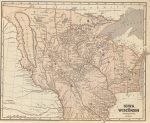
1845 Map Of Iowa
1845 Iowa and Wisconsin Atlas Map
-
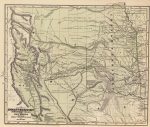
1845 Atlas Map of Iowa Area
1845 A Atlas Map of the Indian Territory, northern Texas and New Mexico showing the great western prairies
-
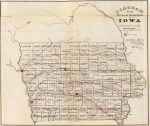
1866 Map Of Iowa
1866 Diagram of the Public Surveys in Iowa
-
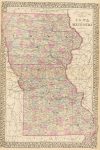
1880 Map Of Iowa
1880 County & township map of the states of Iowa and Missouri
D.O.T. County Road and Highway Maps of Iowa
To View the Map: Just click the image to view the map online. In order to make the image size as small as possible, they were saved on the lowest resolution.
Iowa Map Links
- Iowa State Park Map (mapofus.org)
- Iowa Lakes and Rivers Map (mapofus.org)
- Iowa Map With Cities and Highways (mapofus.org)
- Historical Maps of Iowa (alabamamaps.ua.edu)
- Iowa Digital Map Library (usgwarchives.net)
- Iowa Maps, Atlases & Gazetteers (ancestry.com)
- Iowa Maps – The Perry-Castañeda Library Map Collection (lib.utexas.edu)
- U.S., Indexed County Land Ownership Maps, 1860-1918 (ancestry.com)
- American Memory Map Collection: 1500-2004 (memory.loc.gov)
- Iowa Gazetteer and Business Directory, 1884-1885 (search.ancestry.com) This database contains the 1884-85 Iowa gazetteer and business directory. The gazetteer covers each city, town, village, and settlement in Iowa and includes a description of each place and a directory of the people engaged in business or the professions located there.
- Iowa state gazetteer (search.ancestry.com), embracing descriptive and historical sketches of counties, cities, towns, and villages, including much valuable information regarding the agriculture, manufacturing, commerce, educational and religious institutions, population, and history of the state: to which is added a shippers’ guide and a classified business directory of the manufacturers, merchants, professionals, and tradesmen of Iowa, together with their business address.
- Iowa USGenWeb Archives Digital Map Library (usgwarchives.net)
- Iowa Map Books (amazon.com)

